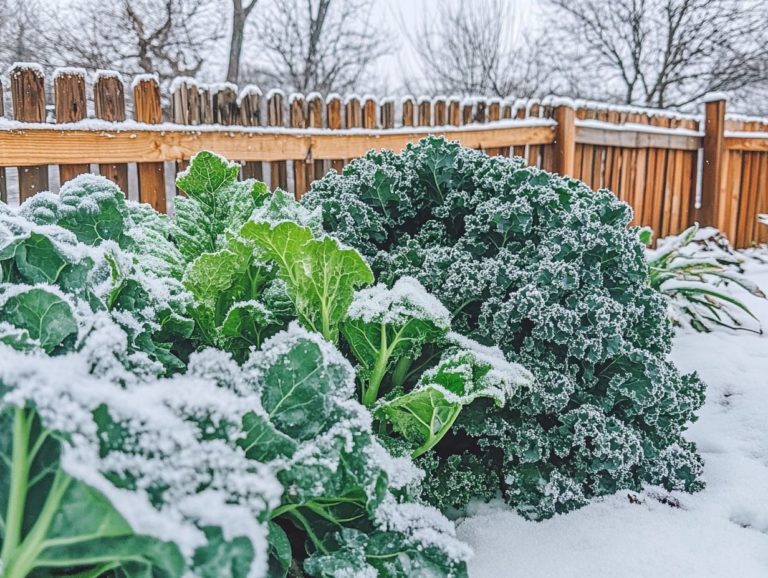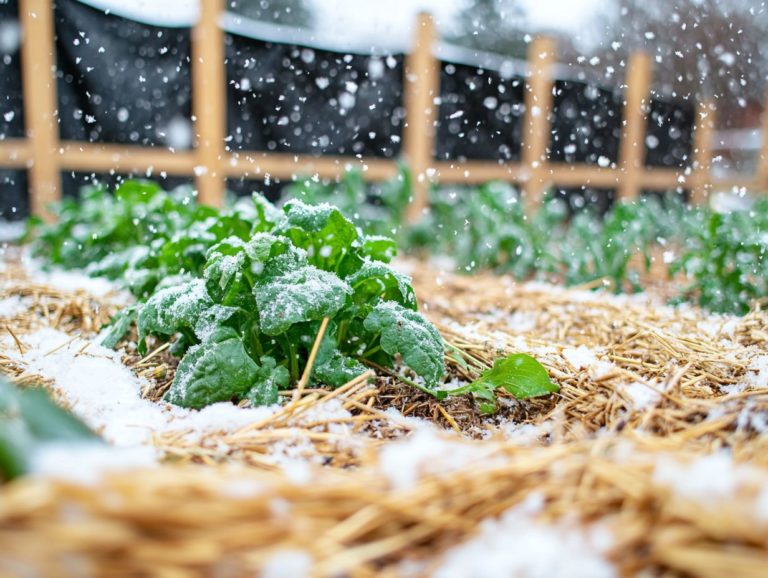5 Ways to Improve Winter Crop Yields
As winter’s chill descends, you might think your planting days are behind you. However, winter crop planting offers a remarkable opportunity to diversify your yields and boost soil health.
Discover the exciting benefits of winter planting! This article delves into five essential strategies for enhancing winter crop yields, from selecting the right crops to employing protective coverings.
It also outlines potential risks and identifies common mistakes to steer clear of, ensuring you re fully equipped to maximize the cold season ahead.
Contents
- Key Takeaways:
- 1. Choose the Right Crops for Winter Planting
- 2. Prepare the Soil Properly
- 3. Use Protective Coverings
- 4. Consider Using Greenhouses or Hoop Houses
- 5. Implement Crop Rotation Techniques
- What Are the Benefits of Winter Crop Planting?
- How Can Crop Yields Be Affected by Winter Weather?
- What Are the Best Crops for Winter Planting?
- How Can Soil Preparation Affect Winter Crop Yields?
- What Types of Protective Coverings Are Available for Winter Crops?
- What Are the Pros and Cons of Using Greenhouses or Hoop Houses for Winter Crops?
- How Can Crop Rotation Improve Winter Crop Yields?
- What Are Some Additional Tips for Maximizing Winter Crop Yields?
- What Are the Risks of Planting Winter Crops?
- How Can Farmers and Gardeners Adjust Their Techniques for Different Winter Climates?
- What Are Some Common Mistakes to Avoid When Planting Winter Crops?
- Frequently Asked Questions
- What are 5 ways to improve winter crop yields?
- Why is crop rotation important for improving winter crop yields in sustainable agriculture?
- How can cover crops, such as winter squash and arugula, benefit winter crop yields?
- What is the significance of choosing winter varieties for crop production, including soybeans and corn?
- How does proper irrigation impact winter crop yields and farming practices?
- Why is it important to control pests and diseases in winter crops for successful production?
- Conclusion
Key Takeaways:

- Choose the right crops for winter planting to ensure they thrive.
- Prepare the soil for optimal growing conditions.
- Utilize protective coverings to shield crops from winter weather.
1. Choose the Right Crops for Winter Planting
Selecting the right crops for winter planting is essential for farmers looking to optimize yields and secure successful harvests, especially in regions like Iowa and Illinois where winter conditions can vary dramatically, influencing the growth and quality of crops like spinach, kale, arugula, and potatoes.
As you make these important decisions, several factors come into play, particularly climate, soil type, and market demand. You need to consider the specific weather conditions in your fields because some areas may retain warmth better than others, making them more suitable for specific crops. For instance, spinach and kale are known for their hardiness and adaptability to colder temperatures, thriving even when frost arrives.
Experts like Gil Gullickson emphasize that understanding local conditions is crucial. By carefully selecting varieties that align with market trends, you can ensure that your plants not only withstand winter s chill but also meet consumer preferences. Successful farming practices also involve crop rotation and cover cropping, which enhance soil health and ultimately contribute to better yields.
2. Prepare the Soil Properly
Proper soil preparation is paramount to achieving optimal fertility and effectively managing the growth of winter crops. This foundational step enables you to enhance both the nutritional quality and yield of your vegetables.
By understanding various soil testing methods, you gain valuable insights into the health and composition of your soil. Techniques such as soil pH testing (which measures the acidity of the soil), nutrient analysis, and organic matter assessment can expose deficiencies and guide you in making necessary amendments.
This approach ensures that your winter planting is rooted in rich, fertile soil. Incorporating organic matter, like compost or well-rotted manure, not only improves soil structure but also enriches nutrient content, allowing for better moisture retention.
Using techniques like cover cropping can protect your soil during the off-season, replenishing nutrients while curbing erosion and weed growth.
3. Use Protective Coverings
Utilizing protective coverings for your winter crops can significantly boost both growth and yield, offering the necessary insulation and defense against the harsh elements you encounter during the colder months.
These coverings think versatile row covers that trap heat and moisture, along with cloches that provide targeted protection are essential tools for enhancing crop resilience. Row covers can extend your growing season, while cloches create the perfect microclimate for your delicate seedlings.
To get the most out of these protective measures, it s crucial to manage them with care. Ensuring proper ventilation is key to preventing overheating, and making regular checks for damage or wear will help prolong their lifespan. Don t overlook the timing of installation and removal, as these factors play a vital role in maintaining healthy crop conditions.
4. Consider Using Greenhouses or Hoop Houses
Greenhouses and hoop houses serve as new options for you as a farmer. They allow you to cultivate winter crops with ease. These structures create controlled environments that enhance growth and protect your plants from the harsh realities of winter weather.
By extending your growing season, you can maintain optimal humidity and temperature levels key ingredients for successful horticulture. With these techniques at your disposal, you can confidently grow popular crops like tomatoes, cucumbers, and peppers, even when temperatures drop.
While the benefits are enticing, it s important to weigh the drawbacks, including initial investment costs and the need for proper ventilation and heating systems. However, many farmers find that the ability to produce high-quality yields year-round makes this investment worthwhile. Ultimately, it leads to more sustainable and fruitful farming practices.
5. Implement Crop Rotation Techniques
Implementing effective crop rotation techniques rejuvenates soil health and maximizes your yield of winter crops. This approach allows you to diversify your planting strategies and mitigate problems with pests and diseases.
These techniques hinge on the systematic rotation of different crops in the same field across consecutive seasons. By alternating crops especially those from diverse plant families you can optimize soil nutrient utilization, enhancing fertility. For example, incorporating legumes helps to naturally fix nitrogen in the soil, providing essential nutrients for the crops that follow. This practice can dramatically disrupt pests’ life cycles, as crops that attract specific pests are not consistently planted in the same areas year after year.
Consider winter crops like wheat and barley as prime candidates for rotation. They improve soil structure and stability, while also reducing weed competition during the colder months. This sets you up for success in the growing season ahead.
What Are the Benefits of Winter Crop Planting?

Winter crop planting presents a wealth of advantages for you as a farmer. It not only extends your growing season but also boosts overall yield while enhancing soil quality and promoting sustainable agricultural practices.
By integrating winter crops into your rotation, you can significantly improve soil health through reduced erosion and enhanced nutrient cycling. Crops like winter rye and barley serve as effective cover crops, preventing weed growth while enriching your soil with valuable organic matter.
Increasing crop diversity leads to a more resilient farming system, helping you mitigate risks associated with pests and diseases. Economically, diversifying your crops allows for multiple income streams and access to winter market opportunities. Successful initiatives in the Midwest have shown that many growers experience higher profitability thanks to winter crop rotations.
How Can Crop Yields Be Affected by Winter Weather?
Winter weather can significantly influence your crop yields. Frost, snow, and temperature fluctuations present challenges that require you to adapt your cultivation strategies for success. Discovering 5 ways to keep your cold garden thriving can help you navigate these conditions effectively.
These elements can hinder not just the growth of your crops but also your harvesting operations, potentially leading to losses. For example, unexpected frost can damage delicate seedlings, while heavy snowfall might delay your access to fields, making timely harvesting a struggle. Moreover, temperature variations can disrupt the delicate balance essential for healthy plant development.
To tackle these challenges head-on, many in the agricultural community, including yourself, are embracing adaptive practices such as sustainable farming methods and innovative strategies:
- Utilizing row covers
- Selecting cold-resistant crop varieties
- Implementing soil management techniques to retain warmth
These strategies not only safeguard your plants but also bolster the resilience of your farming systems against the harsh realities of winter conditions.
What Are the Best Crops for Winter Planting?
The finest crops for winter planting are strong vegetables like spinach, kale, and arugula.
These plants thrive in colder temperatures and provide a nutritious bounty for those aiming to enhance their winter harvests.
Remarkably, these crops endure frost and improve in flavor with the chill, making them a wise selection for anyone wishing to cultivate during the off-season.
When choosing varieties, it s crucial to seek those specifically bred for cold tolerance; they ll provide better disease resistance and higher yields.
Ensure that your soil is well-drained yet retains moisture. Don t overlook the benefits of using row covers to shield young plants from harsh winds and freezing conditions.
Implementing a crop rotation strategy by changing which crops you plant each season can significantly boost soil health, thereby playing a vital role in fertilizing your winter crops effectively and optimizing growth throughout the winter months.
How Can Soil Preparation Affect Winter Crop Yields?
Soil preparation is pivotal in determining the success of your winter crop yields. When you execute management practices effectively, you enhance nutrient availability and create the ideal growing conditions for your crops. For additional tips, check out these winter gardening hacks for success.
Understanding the significance of soil pH which measures how acidic or alkaline your soil is, affecting nutrient availability is crucial. It directly influences nutrient uptake and microbial activity, thereby impacting the overall health of your plants.
By incorporating organic amendments like compost or manure, you improve soil structure and enhance fertility, leading to more robust crops.
Moisture retention is another essential factor to consider. Utilizing mulch or cover crops helps maintain consistent moisture, especially during dry spells.
Regularly testing your soil allows you to tailor your amendments and practices effectively, ensuring you achieve the best possible outcomes for your winter harvest. Act now to test your soil regularly!
What Types of Protective Coverings Are Available for Winter Crops?
Explore the exciting range of protective coverings available for your winter crops, ranging from row covers to cold frames.
Each is meticulously designed to shield your plants from pests and diseases while promoting healthy growth.
These coverings play a pivotal role in maintaining optimal temperatures and humidity levels, both of which can dramatically impact your crop yields.
For instance, row covers create a lightweight barrier that traps heat during chilly nights while still allowing sunlight and moisture to flow through.
Cold frames provide a more substantial solution, generating a mini-greenhouse effect that protects seedlings from frost and extends your growing season.
By strategically selecting and utilizing these coverings, you can elevate your cultivation practices, ensuring that your winter crops not only survive but thrive amid harsh weather conditions.
This thoughtful combination of protection and climate control can lead to a healthier harvest and enhanced profitability.
What Are the Pros and Cons of Using Greenhouses or Hoop Houses for Winter Crops?
Using greenhouses or hoop houses for winter crops brings a unique set of advantages and disadvantages, creating controlled environments that foster plant growth while demanding careful management and investment from you as a farmer.
These structures enable you to significantly extend your growing season. This allows you to cultivate crops that wouldn’t typically withstand the harshness of winter.
By regulating temperature and humidity, these facilities can provide an ideal microclimate for various plants, resulting in higher yields and improved quality.
However, there are potential drawbacks to consider, such as the initial setup costs and the ongoing expenses related to heating, cooling, and maintenance, which can put a strain on your budget.
To truly maximize the benefits, it’s essential for you to analyze your specific circumstances. Assess factors like your local climate, crop selection, and available resources, ensuring that you make informed decisions that align with your operational goals.
How Can Crop Rotation Improve Winter Crop Yields?

Crop rotation will boost your winter crop yields by improving soil health and helping control pests. It also diversifies your farming methods and promotes sustainability.
By switching up your crop types regularly, you can restore essential nutrients, alleviate soil compaction, and enrich the overall biodiversity of your fields. This method encourages stronger root systems and improves moisture retention, ensuring your plants are more resilient during those chilly months.
For example, incorporating legumes into your rotation can fix nitrogen in the soil, nourishing subsequent crops like winter wheat or barley. Rotating your crops also helps break the lifecycle of pests and diseases, leading to healthier plants and increased productivity ultimately nurturing a more sustainable agricultural ecosystem.
What Are Some Additional Tips for Maximizing Winter Crop Yields?
To maximize your winter crop yields, you can employ a range of techniques, such as optimizing your planting schedules, choosing high-quality seeds, and incorporating sustainable farming methods that align with community needs. Additionally, consider exploring the top 5 cold-weather crops you should try for better results.
These strategies not only enhance the quality of your crops but also promote resilience against adverse weather conditions. By implementing effective irrigation methods like drip irrigation or rainwater harvesting, you ensure that your crops receive a consistent moisture supply while conserving precious water resources.
Enhancing soil health through the addition of organic matter, such as compost or cover crops, significantly boosts nutrient availability, leading to improved plant growth. Adopting smart pest control methods helps you manage pests with minimal chemical use, keeping your crops healthy and thriving.
All these methods contribute to increased productivity, translating into higher yields for you as a farmer. To maximize your results, consider referring to the ultimate guide to winter crop care and start incorporating these techniques today to see a difference in your winter yields!
What Are the Risks of Planting Winter Crops?
Planting winter crops carries its fair share of risks, including exposure to harsh weather conditions, heightened vulnerability to diseases, and the ever-present challenges posed by pests. To mitigate these issues, you must act now and adopt 5 winter planting strategies for gardeners!
If not addressed properly, these factors can lead to reduced yields and even crop failures.
The unpredictable winter weather can bring frost damage, or extended wet conditions that foster fungal infections, complicating matters even further. Certain pests may thrive in milder winter temperatures, making it crucial to stay vigilant.
To mitigate these risks, consider:
- Selecting crops that are less likely to get sick
- Timing your planting to avoid frost
- Using protective covers for your crops
Regular monitoring and scouting for pests and diseases are also essential for maintaining crop health during this challenging season.
How Can Farmers and Gardeners Adjust Their Techniques for Different Winter Climates?
You can effectively adjust your farming and gardening techniques for various winter climates by understanding local weather patterns and tailoring your planting and management strategies accordingly.
By assessing the unique characteristics of your specific region such as average temperatures, frost dates, and precipitation levels you can make informed decisions about which crops are best suited for winter growth. For instance, in areas with milder winters, you ll find that cool-season crops like kale and spinach can thrive beautifully.
On the other hand, harsher climates may require you to utilize cold frames or row covers to protect more sensitive varieties.
Implementing ways to care for your soil, like mulching to retain moisture and enhance insulation, can further support the viability of your crops. Additionally, using essential tools for protecting winter crops and adapting your techniques to local conditions not only boosts yields but also promotes sustainable agricultural practices, setting you up for a rewarding winter harvest.
What Are Some Common Mistakes to Avoid When Planting Winter Crops?
Common mistakes made during the planting of winter crops can significantly diminish yields and even lead to crop failure, underscoring the importance of meticulous planning and execution for success in sustainable agriculture.
When critical factors such as timing, soil preparation, and pest management are overlooked, problems tend to escalate. For instance, delaying planting until the last moment can expose your crops to unpredictable weather, while inadequate soil preparation may result in poor drainage or nutrient deficiencies.
Ignoring pest management strategies isn t just a risk to crop health; it can also contribute to long-term soil degradation.
To navigate these challenges effectively, establish a clear planting schedule, perform comprehensive soil tests, and adopt combined pest control methods. Additionally, utilizing the right tools is crucial; refer to the essential equipment for winter crop care. This approach will help you cultivate healthier, more resilient winter crops.
Frequently Asked Questions
Are you ready to take on winter planting? Let’s dive into your questions!
What are 5 ways to improve winter crop yields?

- Rotate crops: Rotating crops helps replenish nutrients in the soil. This practice reduces nutrient depletion and improves winter crop yields.
- Use cover crops: Cover crops protect the soil from erosion and add nutrients back, leading to healthier winter crops with higher yields.
- Plant winter varieties: Choose crop varieties bred for winter conditions. These varieties often yield better and produce higher quality crops.
- Implement proper irrigation: Effective irrigation ensures crops get enough water without overwatering, positively impacting yields.
- Control pests and diseases: Winter crops are more susceptible to pests and diseases. Proper control measures can help prevent yield losses.
Why is crop rotation important for improving winter crop yields in sustainable agriculture?
Crop rotation is key to improving winter crop yields. It replenishes soil nutrients and reduces the risk of nutrient depletion. Additionally, it helps break the cycle of pests and diseases that can affect crops like spinach and kale.
How can cover crops, such as winter squash and arugula, benefit winter crop yields?
Cover crops benefit winter crop yields by shielding the soil from erosion. They also add nitrogen back into the soil and improve soil structure. This leads to healthier crops with higher yields, especially for vegetables.
What is the significance of choosing winter varieties for crop production, including soybeans and corn?
Selecting winter varieties is significant because these crops are specifically bred to thrive in cold conditions. This results in better yields and higher quality produce, boosting local markets.
How does proper irrigation impact winter crop yields and farming practices?
Proper irrigation is crucial for improving winter crop yields. It ensures crops receive enough water without being overwatered. This helps maintain essential soil moisture levels for crop growth and aligns with successful farming strategies.
Why is it important to control pests and diseases in winter crops for successful production?
Pests and diseases can significantly harm winter crop yields. Therefore, it’s essential to implement control measures. This may involve using natural methods like crop rotation and introducing beneficial insects or using organic pesticides when necessary.
Conclusion
Implementing these strategies can lead to bigger harvests this winter. For example, consider exploring 5 ways to keep soil healthy in winter. Take action now to improve your winter yields and enhance your farming practices!






